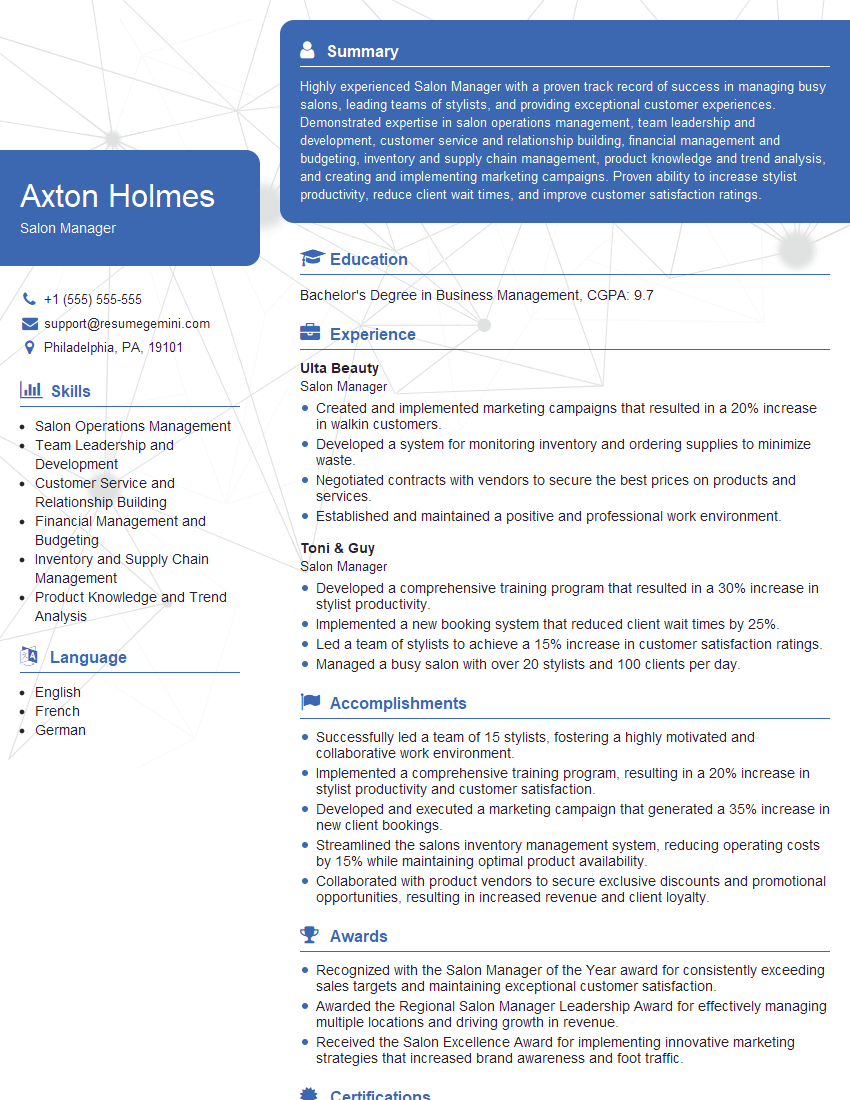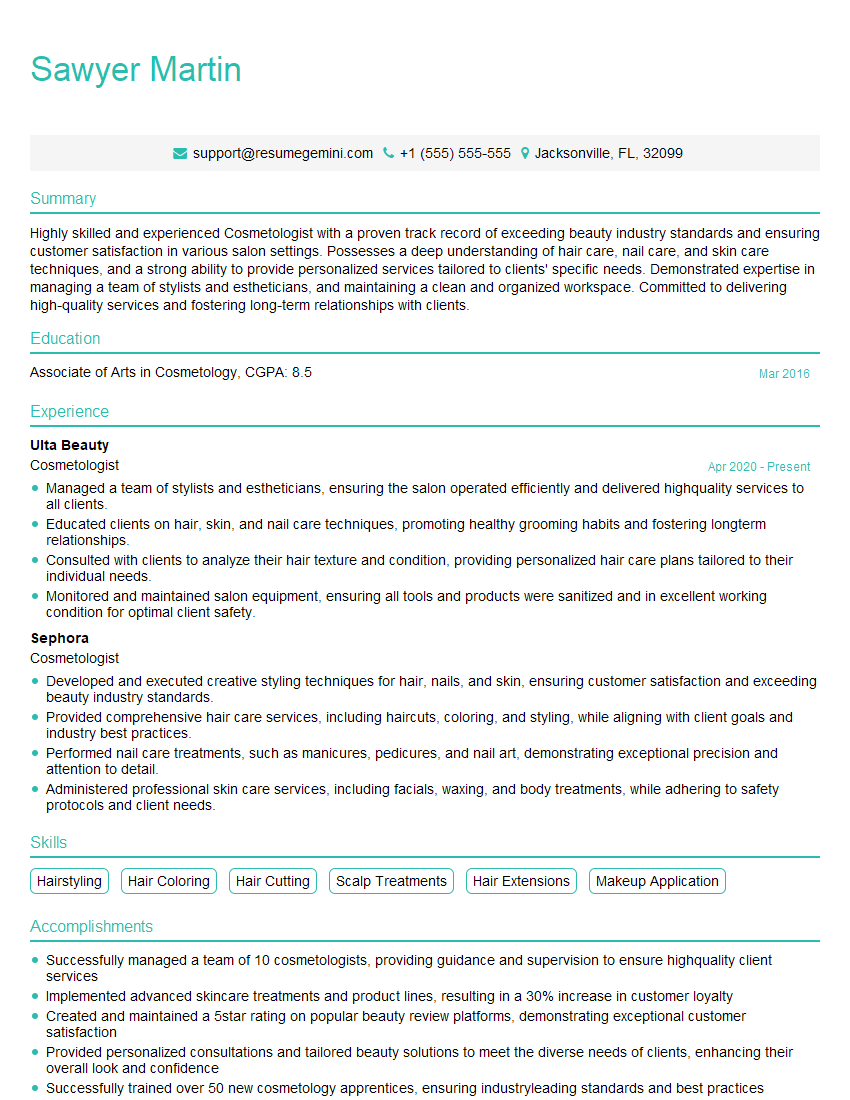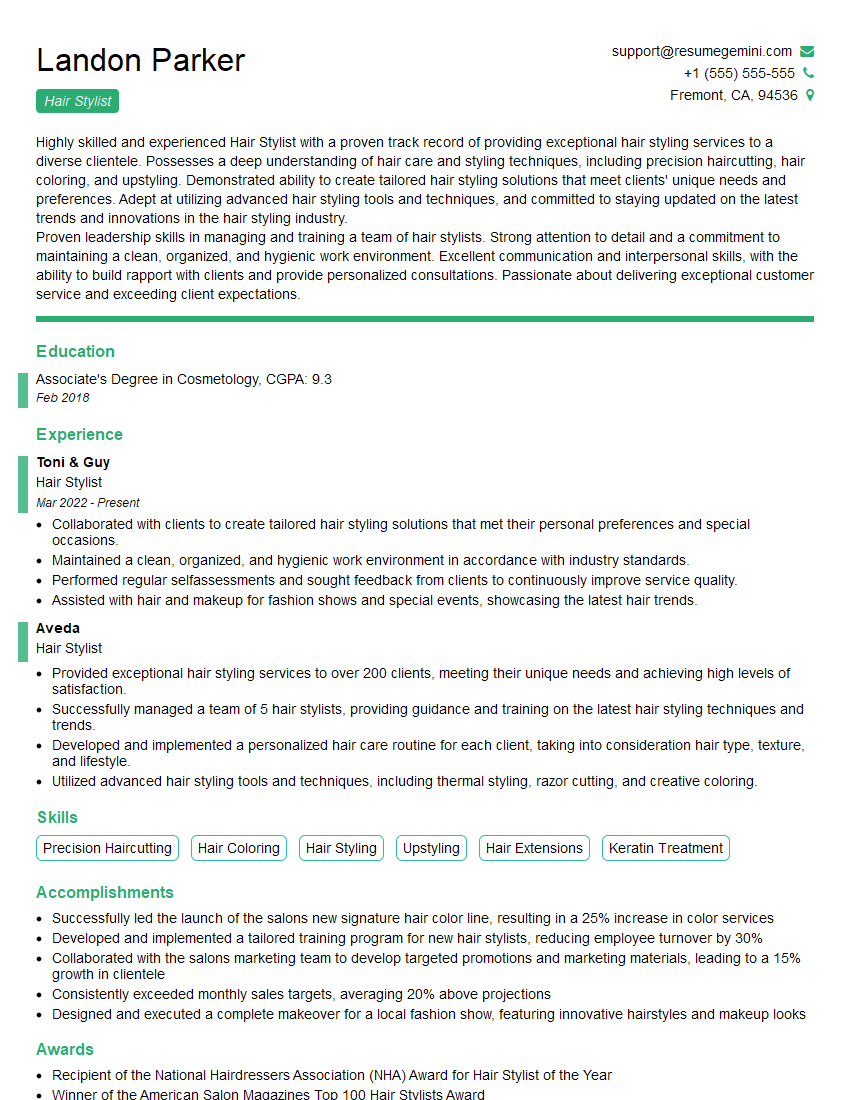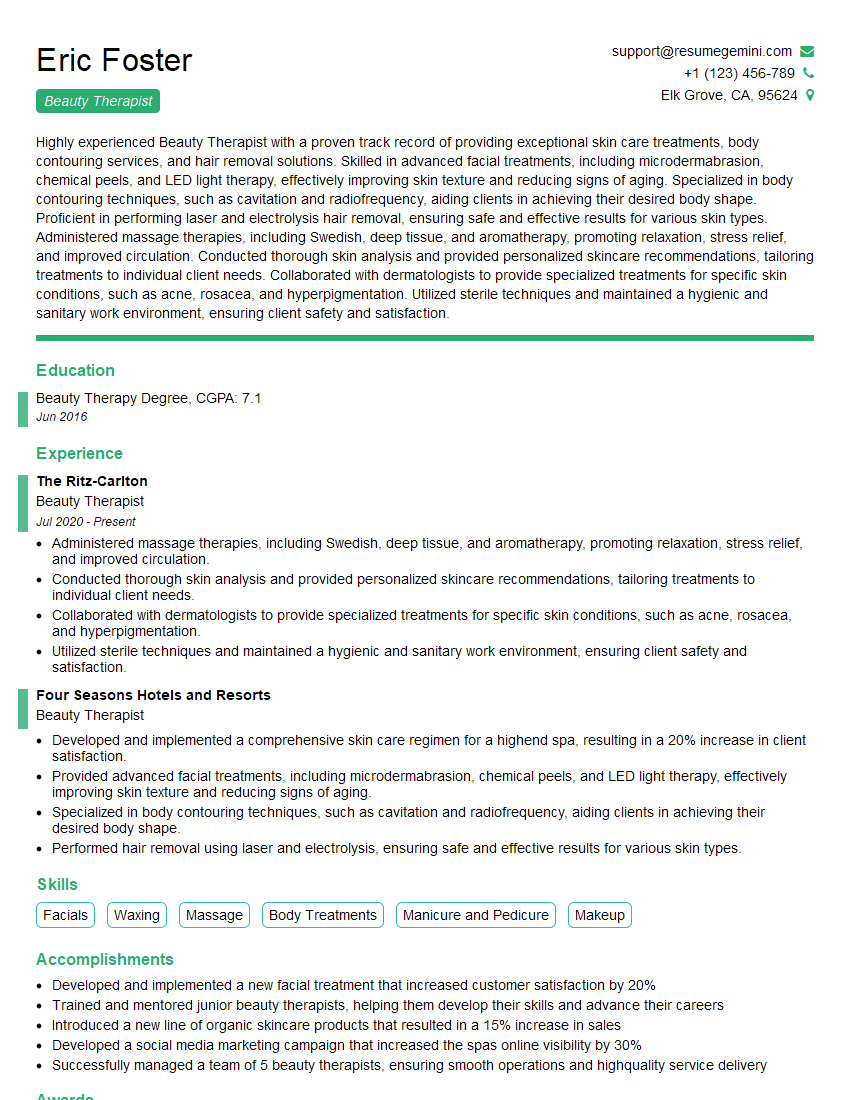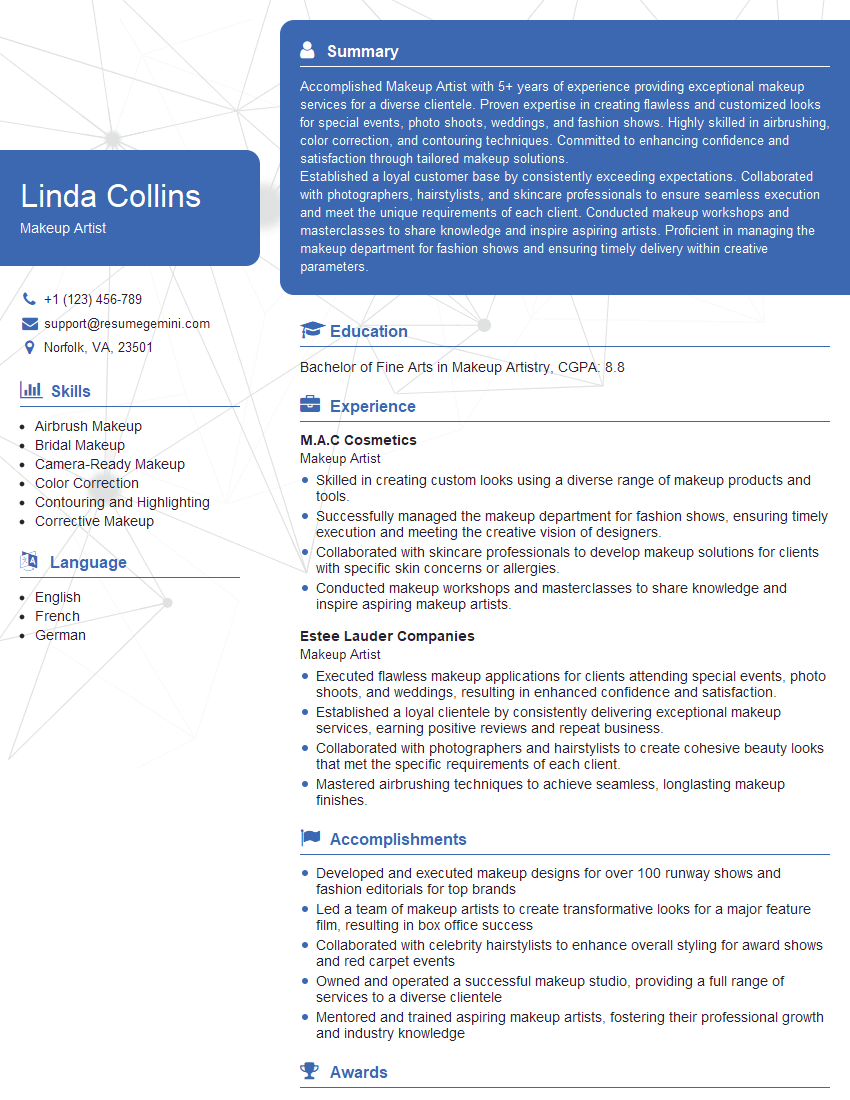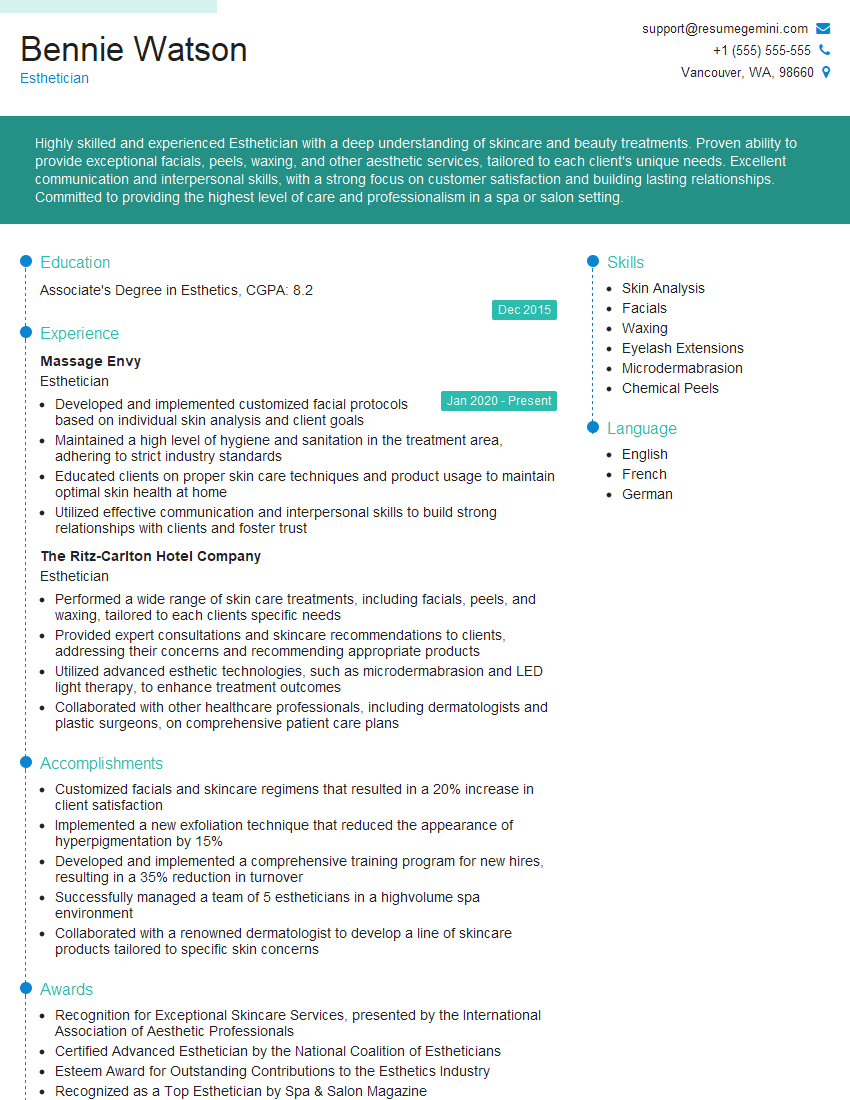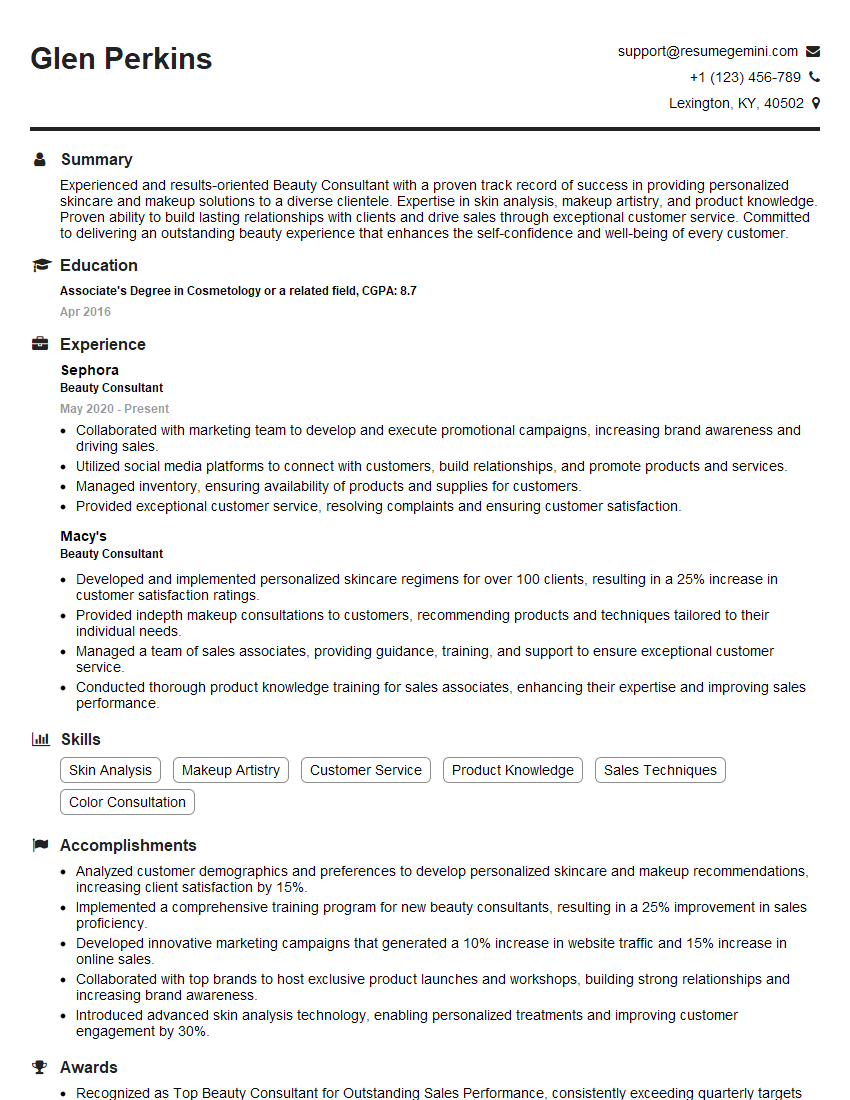Cracking a skill-specific interview, like one for Hair and Makeup, requires understanding the nuances of the role. In this blog, we present the questions you’re most likely to encounter, along with insights into how to answer them effectively. Let’s ensure you’re ready to make a strong impression.
Questions Asked in Hair and Makeup Interview
Q 1. What are the different types of hair textures and how would you approach styling each?
Hair texture is categorized by the shape and diameter of the hair strand, significantly impacting styling approaches. We generally classify hair textures as straight, wavy, curly, and coily, each with its own subcategories.
- Straight Hair: This hair type is typically smooth and easily styled. Approaches range from sleek blowouts using round brushes and heat protectants to adding volume with teasing and volumizing products. Think of the versatility—a simple ponytail, elegant updo, or bouncy curls are all achievable.
- Wavy Hair: Wavy hair exhibits an ‘S’ pattern. Styling focuses on enhancing the natural wave or creating defined, loose curls using techniques like diffusing or air drying with styling creams or mousses. Over-styling can lead to frizz, so products that hydrate and define are key.
- Curly Hair: This texture forms tighter spirals or ringlets. Styling here emphasizes hydration and minimizing frizz. Techniques often involve using leave-in conditioners, curl creams, and avoiding harsh brushing. The goal is to enhance the curl pattern, not fight it.
- Coily Hair: Coily hair is tightly coiled, often forming a ‘Z’ pattern. It’s very delicate and prone to dryness. Styling should prioritize moisture and gentle handling. Products with high moisturizing power, like shea butter or coconut oil, are crucial. Protective styles like braids or twists are often preferred to minimize manipulation and breakage.
Understanding the client’s specific hair texture and porosity (how well the hair absorbs moisture) is paramount to choosing the right products and techniques for optimal results. I always consult with my clients to understand their hair history and goals before beginning any styling process.
Q 2. Describe your experience with various hair coloring techniques.
My experience with hair coloring encompasses a broad range of techniques, from classic single-process coloring to more advanced methods.
- Single-Process Coloring: This involves applying one color to the entire head for a uniform shade. It’s a great option for covering gray hair or creating a solid base color.
- Highlighting/Lowlighting: These techniques involve strategically lightening or darkening sections of hair to add dimension and depth. Balayage, foil highlights, and ombre are popular examples. I consider factors such as the client’s skin tone, eye color, and desired style when selecting placement and shade.
- Color Correction: This is a specialized area requiring a deep understanding of color theory. I’ve handled various correction scenarios, addressing unwanted tones or previous color mishaps. The process involves strategically lifting and depositing color to achieve the desired outcome.
- Permanent vs. Demi-Permanent vs. Temporary Color: I’m proficient in all three types, selecting based on the client’s needs and desired longevity. Permanent colors provide lasting results, demi-permanent offers a gentler alternative with less commitment, and temporary options are ideal for a quick change.
Safety and client consultation are my top priorities. I always perform a strand test before any full-head application to assess the hair’s reaction to the chemicals and ensure the final color meets expectations.
Q 3. Explain your process for creating a natural-looking makeup application.
Creating natural-looking makeup involves focusing on enhancing features rather than masking them. My process is built around less-is-more philosophy, prioritizing flawless skin preparation.
- Skin Prep: This is the most crucial step. I start with a thorough cleansing, followed by moisturizing and priming the skin to create a smooth canvas. The right primer can help even out skin tone and texture, making the foundation application look more natural.
- Foundation: I use a lightweight foundation or tinted moisturizer, selecting a shade that closely matches the client’s skin tone. Blending is key—I use a damp sponge or brush to seamlessly blend the foundation into the skin, avoiding a mask-like effect.
- Concealer: Concealer is used sparingly to target specific areas needing coverage, like blemishes or dark circles. I prefer to use a shade that is one or two shades lighter than the foundation to brighten.
- Blush, Bronzer, Highlighter: These products add dimension and warmth to the face. I use subtle, natural-looking shades and apply them in a way that mimics a natural flush or sun-kissed glow.
- Brows & Lashes: Well-groomed brows frame the face beautifully. I either lightly fill in sparse areas or gently shape them using brow gel or pencil. Mascara adds definition to the eyes without appearing heavy.
- Lips: A neutral lip color or lip balm completes the look. A lip liner can help define the lip shape but is used sparingly and blended well.
Throughout the process, I emphasize blending techniques to ensure a seamless and natural finish. The aim is not to cover up the client’s natural beauty, but rather to enhance it.
Q 4. How do you adapt your makeup techniques for different skin tones and types?
Adapting makeup techniques for different skin tones and types is crucial for achieving the best results and ensuring inclusivity. My approach considers both the undertones (warm, cool, neutral) and the skin’s type (dry, oily, combination, sensitive).
- Foundation Shade Selection: For deeper skin tones, I select foundations with a range of undertones to accurately match the client’s skin. I avoid foundations that are too ashy or orange. For lighter skin tones, I focus on finding a foundation that matches the skin tone perfectly, without appearing cakey.
- Product Formulation: Oily skin benefits from oil-free or matte foundations, while dry skin needs hydrating formulas. Sensitive skin requires hypoallergenic and fragrance-free products. I always inquire about skin sensitivities and conditions before choosing products.
- Concealer Application: I use color correction techniques for different concerns. For example, a green concealer can neutralize redness, while a peach or orange concealer can brighten under-eye circles on darker skin tones.
- Blush and Bronzer Shades: I select blush and bronzer shades that complement the client’s skin tone. Deeper skin tones can beautifully carry vibrant colors while lighter skin tones might benefit from more subtle, peachy tones.
Understanding the needs of each skin tone and type enables me to tailor my makeup techniques and product selections, resulting in a customized and flattering look for every client.
Q 5. What are your go-to products for achieving a specific makeup look (e.g., smoky eye)?
For a classic smoky eye, my go-to products are:
- Eye Shadow Palette: A palette with a range of neutral matte and shimmery shades, including a dark charcoal or black, a medium gray, a light beige, and a shimmery highlight shade.
- Eye Shadow Primer: This helps the eyeshadow stay in place and prevents creasing. I use a long-lasting formula.
- Angled Brush: An angled brush is essential for precise application of the dark shadow along the lash line and outer corner of the eye.
- Blending Brush: A fluffy blending brush is used to soften the edges of the dark shadow and create a seamless smoky effect.
- Black Eyeliner: I use a black eyeliner pencil or gel liner to define the eyes. A subtle wing adds extra drama but is optional.
- Mascara: A volumizing mascara completes the look, enhancing the lashes for a captivating finish.
The key to a successful smoky eye lies in skillful blending. I start by applying the darkest shade in the crease and along the lash line, gradually blending outwards and upwards. The lighter shades create highlights and add dimension.
Q 6. How do you handle challenging clients or situations?
Handling challenging clients or situations requires patience, diplomacy, and problem-solving skills. My approach focuses on clear communication and finding mutually agreeable solutions.
- Active Listening: I pay close attention to my clients’ concerns and try to understand their perspective.
- Clear Communication: I clearly explain my process and answer their questions in a transparent way. I show pictures and offer various options, making them actively participate in the process.
- Conflict Resolution: If a conflict arises, I address it calmly and professionally, focusing on finding a compromise that satisfies both parties.
- Setting Boundaries: While prioritizing customer satisfaction, I also maintain professional boundaries. I firmly communicate any limitations or time constraints.
- Seeking Feedback: I regularly seek feedback to learn from mistakes and adapt my communication styles.
I remember one client who arrived with a very specific vision that conflicted with what I felt was best for her face shape and hair type. Through patient discussion and showing examples, I helped her understand why my suggestions would be more flattering. Ultimately, she trusted my expertise, and we achieved a fantastic result. Building trust and rapport is essential in handling any challenging interaction.
Q 7. Describe your experience with updos and various hairstyles.
My experience with updos and various hairstyles is extensive. I’m proficient in a range of styles, from classic chignons and French twists to more modern and intricate designs.
- Classic Updos: I excel in creating timeless updos like chignons, buns, and French twists, adapting them to suit different hair lengths and textures. These styles are often chosen for formal events or weddings.
- Braids: I’m skilled in various braiding techniques, including French braids, fishtail braids, Dutch braids, and incorporating braids into more complex updos.
- Modern Styles: I stay updated on current trends, incorporating elements like loose waves, textured finishes, and decorative accessories to create unique and stylish looks. I can create styles ranging from boho chic to sleek and polished depending on the client’s desire.
- Hair Extensions: I’m experienced in working with hair extensions to add length, volume, or create elaborate updos. I understand different extension types, which helps to select the appropriate one for the client’s hair.
Each hairstyle is tailored to the client’s individual features, hair type, and desired outcome. Before starting any style, I always assess the client’s hair health and discuss their expectations to ensure the final look is both beautiful and achievable.
Q 8. What sanitation and hygiene practices do you follow?
Sanitation and hygiene are paramount in my practice. I meticulously follow a strict protocol to ensure client safety and prevent the spread of infection. This begins with thorough handwashing before and after each client using antibacterial soap, and the use of disposable gloves for all services. All tools and brushes are sanitized using a hospital-grade disinfectant solution between each client, and I use disposable applicators whenever possible. Work surfaces are disinfected before and after every appointment. For reusable tools, I follow a strict cleaning and sterilization procedure, often using UV sterilization equipment as an added precaution. Maintaining a clean and organized workspace is essential; this includes regularly cleaning and disinfecting all surfaces and equipment. I also ensure that all products are stored correctly to maintain their quality and prevent contamination. Think of it like a surgeon preparing for an operation – precision and hygiene are non-negotiable.
Q 9. How do you stay updated on the latest hair and makeup trends?
Staying current in the dynamic world of hair and makeup requires a multi-pronged approach. I regularly subscribe to professional industry magazines like Vogue and Harper’s Bazaar, and attend masterclasses and workshops presented by leading makeup artists and hairstylists. I actively follow influential makeup artists and hairstylists on platforms like Instagram and TikTok, observing their techniques and the trends they showcase. I also attend industry trade shows, such as Cosmoprof, where I can see new products and techniques firsthand. Furthermore, I constantly experiment and practice new techniques myself, always seeking to improve my skills and stay ahead of the curve. It’s a continuous learning process; the moment you stop learning, you start to fall behind.
Q 10. Explain your understanding of color theory as it relates to hair and makeup.
Color theory is the foundation of both hair and makeup artistry. Understanding the color wheel – the relationship between primary, secondary, and tertiary colors – is crucial. For instance, in makeup, knowing that complementary colors (opposite each other on the wheel, like blue and orange) create contrast and can be used to enhance features. Using a peachy blush to counteract any dullness in the skin, or a deep plum lipstick to make teeth appear whiter, are examples of this. In hair, understanding the undertones of hair color is essential for achieving the desired results. For example, warm undertones in a client’s hair might require a different color correction approach than those with cool undertones. Using the color wheel allows us to neutralize unwanted tones, create depth, and blend colors harmoniously. It’s all about creating balance and harmony on the face and with the hair color to enhance natural beauty.
Q 11. What are some common hair and scalp problems and their solutions?
Common hair and scalp problems vary, but some of the most frequent issues I encounter include dandruff, dry scalp, oily scalp, hair breakage, and hair thinning. Dandruff often responds well to medicated shampoos containing ingredients like selenium sulfide or zinc pyrithione. Dry scalp can be addressed with moisturizing shampoos and conditioners, sometimes requiring the use of scalp oils. For oily scalps, clarifying shampoos are effective, helping to remove excess oil. Hair breakage can be caused by several factors, including excessive heat styling, chemical treatments, and lack of moisture. Addressing this often involves reducing heat styling, using protein-rich treatments, and incorporating leave-in conditioners. Hair thinning can be related to genetics, hormonal changes, or nutritional deficiencies. Solutions range from minoxidil treatments (under medical supervision) to lifestyle changes focusing on diet and stress management. A thorough consultation with the client is key to identify the root cause and tailor the appropriate solution.
Q 12. How do you consult with clients to determine their needs and preferences?
Client consultation is the most vital aspect of my work. It begins with a detailed discussion about the occasion (wedding, photoshoot, everyday look), their personal style, and preferences. I examine their hair and skin type, noting any concerns they may have. I show them pictures of different looks, and we discuss their comfort levels with various styles and intensities. This allows me to understand their vision and tailor the makeup and hair to complement their features and personality. I’m always keen to hear their ideas and preferences; collaboration is key to achieving a look that they feel confident and radiant in. It’s a conversation, not just a consultation.
Q 13. Describe your experience with airbrush makeup application.
I have extensive experience with airbrush makeup application. It offers a flawless, natural finish with a lightweight feel, perfect for photography and events where longevity is essential. The technique involves using an airbrush gun to spray a fine mist of makeup onto the skin. I find that it minimizes the appearance of pores and provides excellent coverage without looking heavy or cakey. The process is also hygienic, using disposable cups and stencils to prevent cross-contamination. While it requires specialized equipment and training, the results are well worth it, especially for bridal makeup or high-definition photography where imperfections must be minimized.
Q 14. What is your experience with special effects makeup?
My experience with special effects makeup ranges from creating character looks for theatrical productions to designing realistic wounds for film or photography. This involves advanced techniques like prosthetic application, sculpting with wax, and using various paints and pigments to create realistic effects. I’m proficient in various techniques, including creating scars, bruises, cuts, and other injuries. Safety is paramount in this area, and I’m meticulous in using appropriate materials and adhering to sanitary procedures to prevent skin irritation or infection. For example, I use medical-grade adhesives and ensure proper skin preparation before applying any prosthetics. Creating believable special effects requires a strong understanding of anatomy and a keen eye for detail. It’s a creatively challenging and rewarding aspect of makeup artistry.
Q 15. How do you manage your time effectively during a busy salon day?
Effective time management in a busy salon is crucial for maintaining client satisfaction and productivity. My approach involves a multi-pronged strategy. First, I meticulously schedule appointments, allowing sufficient time for each service, factoring in potential delays. I utilize a digital scheduling system that sends reminders to clients and integrates with my inventory management. Second, I prioritize tasks using a system similar to time blocking. For example, I might dedicate the first two hours to hair coloring, followed by cuts and styling. Third, I maintain a clean and organized workspace. A streamlined environment minimizes time wasted searching for tools or products. Finally, I actively communicate with clients throughout the process, keeping them informed of the timeline and addressing any concerns promptly. This proactive communication helps manage expectations and avoids unexpected delays. Think of it like conducting an orchestra – every instrument (task) needs to play its part in harmony for a successful performance (salon day).
Career Expert Tips:
- Ace those interviews! Prepare effectively by reviewing the Top 50 Most Common Interview Questions on ResumeGemini.
- Navigate your job search with confidence! Explore a wide range of Career Tips on ResumeGemini. Learn about common challenges and recommendations to overcome them.
- Craft the perfect resume! Master the Art of Resume Writing with ResumeGemini’s guide. Showcase your unique qualifications and achievements effectively.
- Don’t miss out on holiday savings! Build your dream resume with ResumeGemini’s ATS optimized templates.
Q 16. What are the different types of hair extensions and their application methods?
Hair extensions come in various types, each with its own application method.
- Weave-in extensions: These are sewn into cornrows or braids using a needle and thread. This is a long-lasting method, but requires significant skill and time for installation. I’ve had great success with this method for clients needing significant volume or length.
- Tape-in extensions: These come pre-taped and are applied directly to the hair using heat or pressure. It’s a relatively quick method, ideal for adding subtle volume or highlights, and requires less maintenance than weaves. I find this method excellent for clients with finer hair.
- Clip-in extensions: These are temporary extensions attached to the hair using clips. They are easy to apply and remove, making them perfect for special occasions or experimenting with different styles. I recommend these for clients who want a temporary change or are unsure about commitment.
- Fusion/Keratin bond extensions: Individual strands of hair are bonded to the natural hair using a heated keratin bond. This offers a seamless and natural look, but requires precision and experience to avoid damaging the hair. This is my go-to for clients wanting a very natural look and substantial length.
Proper aftercare is essential for all extension types to ensure longevity and prevent damage. I always educate my clients on the specific care instructions for their chosen method.
Q 17. How familiar are you with different types of brushes and tools?
My familiarity with brushes and tools extends across various hair types and styling needs. I’m proficient with round brushes for blowouts (creating volume and bounce), paddle brushes for detangling and smoothing, teasing brushes for creating volume at the roots, and various types of combs – from wide-tooth combs for detangling curly hair to fine-tooth combs for precision sectioning. In addition to this, I’m comfortable using different types of curling irons, flat irons, and hot rollers, each chosen based on the desired outcome and hair texture. I understand the importance of maintaining the hygiene of my tools and regularly sanitize them to prevent the spread of bacteria or infection.
Q 18. Describe your experience with various makeup palettes and brands.
My experience with makeup palettes and brands is extensive. I’ve worked with high-end brands such as Chanel, Dior, and MAC, as well as more affordable options like BH Cosmetics and Colour Pop. My selection depends on the client’s skin type, desired look, and budget. I understand the nuances of different formulations – for example, I know that matte foundations are best for oily skin, while dewy formulas suit dry skin. I’m equally comfortable creating natural, everyday looks using subtle palettes, as I am with dramatic, evening looks requiring bolder shades and techniques. I’m always researching and experimenting with new products and trends to expand my knowledge and stay current with the industry.
Q 19. How do you handle client allergies or sensitivities?
Handling client allergies or sensitivities is paramount. Before any service, I always conduct a thorough consultation to identify potential allergies or sensitivities. This involves asking about previous reactions to products, ingredients, or specific brands. I maintain a detailed record of these allergies, noting specific products or ingredients to avoid. I prioritize using hypoallergenic products whenever possible, and I always perform a patch test before applying any new product, particularly on sensitive skin or areas prone to reactions. In case of a reaction, I have a well-defined protocol, including first-aid measures and the ability to contact medical professionals if necessary.
Q 20. What are your strengths and weaknesses as a hair stylist/makeup artist?
My strengths as a hair stylist and makeup artist lie in my adaptability and creativity. I’m adept at listening to client needs and translating their vision into a reality, often suggesting modifications to optimize the look based on their features and preferences. I’m detail-oriented and strive for perfection in my work. My weakness is sometimes overcommitting to multiple tasks simultaneously, which can impact efficiency. To mitigate this, I am working on improving my time management skills through prioritization and delegation where possible.
Q 21. Explain your experience with working with different hair lengths and styles.
My experience with different hair lengths and styles is extensive. I’m equally comfortable working with short, layered bobs, long, flowing tresses, and everything in between. I have experience styling all hair types – from fine, straight hair to thick, curly hair and everything in between. My expertise includes various cutting techniques, including blunt cuts, layered cuts, texturizing, and various styling techniques including updos, braids, and loose waves. For longer hair, I am experienced in creating intricate updos and intricate braids that require a high level of skill and patience. I adapt my approach based on the client’s hair type, texture, and desired style, always prioritizing the health and integrity of their hair.
Q 22. How do you ensure client satisfaction and build rapport?
Client satisfaction is paramount. Building rapport starts with a consultation – a genuine conversation to understand their vision, lifestyle, and event. I actively listen, ask clarifying questions, and offer tailored advice, ensuring they feel heard and understood. For example, if a bride expresses anxiety about her wedding day look, I’ll offer reassurance and show her various options to alleviate her concerns. Post-service, I follow up to ensure they’re happy and address any immediate issues. This consistent attention and personalized service fosters trust and loyalty, resulting in repeat business and referrals.
Q 23. What are your pricing strategies for your services?
My pricing is structured to reflect the complexity and time involved in each service. I offer tiered packages for different events (e.g., bridal, prom, special occasion) and individual services (e.g., hair styling, makeup application). Prices are competitive yet reflect the quality of my products and the expertise I bring. For example, a full bridal package includes a trial run, allowing adjustments before the big day, and is priced accordingly. I also offer add-on services like airbrush makeup or specific updo styles with clear pricing to maintain transparency.
Q 24. What are your marketing and self-promotion strategies?
My marketing strategy leverages both online and offline channels. Online, I have a professional website showcasing my portfolio, client testimonials, and pricing. I actively maintain social media profiles (Instagram, Facebook) with high-quality images and videos, highlighting my work and engaging with potential clients. Offline, I network with local photographers, event planners, and boutiques. I also participate in bridal shows and community events to reach a wider audience. Word-of-mouth referrals remain a powerful tool, which is why client satisfaction is a top priority.
Q 25. How do you handle complaints or negative feedback from clients?
Handling complaints professionally is crucial. I always listen empathetically to the client’s concerns without interruption. I then calmly explain my approach, offering a sincere apology if a mistake was made. My goal is to find a mutually agreeable solution – perhaps a complimentary service or a partial refund – depending on the nature of the complaint. Even if the client is unreasonable, I maintain a calm and respectful demeanor, aiming for a resolution that preserves my professional image. Constructive criticism is valuable, so I document feedback to improve my services.
Q 26. Describe your experience using various hair styling tools (e.g., curling irons, flat irons).
I’m proficient in using various hair styling tools. With curling irons, I understand how different barrel sizes and temperatures create various curls – from loose waves to tight ringlets. I adapt my technique depending on hair texture and length, using heat protectant sprays to prevent damage. Similarly, I utilize flat irons for sleek styles and precise straightening, knowing how to section hair effectively to avoid heat damage. My experience extends to other tools like hot rollers, round brushes, and diffusers – each selected to achieve a specific style while prioritizing hair health.
Q 27. How do you maintain the quality of your tools and equipment?
Maintaining my tools is paramount. After each use, I meticulously clean curling irons and flat irons with a damp cloth to remove product residue. I regularly inspect cords for damage and replace them if necessary. I also store my tools in a protective case to avoid damage or accidental breakage. Sharp shears are regularly sharpened by a professional to ensure precision cuts. This preventative maintenance ensures the longevity of my equipment and prevents potential issues during client services. Clean tools are also crucial for hygiene.
Q 28. What are some common mistakes to avoid in hair and makeup application?
Several common mistakes can be avoided. In makeup, applying foundation that’s too dark or too light for the skin tone is a frequent issue; choosing the right shade is key. Skipping primer can lead to uneven application and shorter wear time. For hair, using too much product can make hair look greasy or weighed down. Over-processing hair with heat tools can cause breakage and damage. Ignoring hair type and texture when choosing styling products can lead to disappointing results. Understanding the client’s hair and skin type and choosing appropriate products and techniques will prevent common pitfalls.
Key Topics to Learn for Your Hair and Makeup Interview
- Hair Styling Techniques: Understanding various cutting, coloring, and styling techniques. Be prepared to discuss your proficiency with different tools and products.
- Makeup Application: Demonstrate knowledge of various makeup styles (natural, dramatic, editorial, etc.) and their application for different occasions and skin tones. Discuss your understanding of color theory and its application to makeup.
- Skincare Knowledge: Showcase your understanding of different skin types and conditions, and how to prep skin for makeup application. Discuss appropriate product recommendations based on skin needs.
- Product Knowledge: Be prepared to discuss your familiarity with various high-quality hair and makeup brands and their product lines. Highlight your ability to select products based on client needs and desired outcomes.
- Client Consultation & Communication: Explain your approach to understanding client needs, preferences, and providing tailored solutions. Discuss effective communication techniques for building rapport and trust.
- Hygiene and Sanitation: Demonstrate a strong understanding of hygiene protocols and sanitation practices within the industry, ensuring a safe and healthy working environment for both you and your clients.
- Trend Awareness: Discuss your understanding of current and upcoming trends in hair and makeup and your ability to adapt your skills to meet evolving demands.
- Problem-Solving: Be ready to discuss instances where you’ve encountered challenges (e.g., difficult hair texture, a client’s dissatisfaction) and how you successfully resolved them. Highlight your creative thinking and adaptability.
Next Steps
Mastering the art of hair and makeup opens doors to exciting career opportunities, from freelance artistry to high-end salons and beyond. To maximize your job prospects, invest time in creating a polished and ATS-friendly resume that showcases your skills and experience effectively. ResumeGemini is a trusted resource that can help you build a professional resume designed to get noticed. Examples of resumes tailored to the Hair and Makeup industry are available to guide you. Take the next step towards your dream career!
Explore more articles
Users Rating of Our Blogs
Share Your Experience
We value your feedback! Please rate our content and share your thoughts (optional).
What Readers Say About Our Blog
Hello,
We found issues with your domain’s email setup that may be sending your messages to spam or blocking them completely. InboxShield Mini shows you how to fix it in minutes — no tech skills required.
Scan your domain now for details: https://inboxshield-mini.com/
— Adam @ InboxShield Mini
Reply STOP to unsubscribe
Hi, are you owner of interviewgemini.com? What if I told you I could help you find extra time in your schedule, reconnect with leads you didn’t even realize you missed, and bring in more “I want to work with you” conversations, without increasing your ad spend or hiring a full-time employee?
All with a flexible, budget-friendly service that could easily pay for itself. Sounds good?
Would it be nice to jump on a quick 10-minute call so I can show you exactly how we make this work?
Best,
Hapei
Marketing Director
Hey, I know you’re the owner of interviewgemini.com. I’ll be quick.
Fundraising for your business is tough and time-consuming. We make it easier by guaranteeing two private investor meetings each month, for six months. No demos, no pitch events – just direct introductions to active investors matched to your startup.
If youR17;re raising, this could help you build real momentum. Want me to send more info?
Hi, I represent an SEO company that specialises in getting you AI citations and higher rankings on Google. I’d like to offer you a 100% free SEO audit for your website. Would you be interested?
Hi, I represent an SEO company that specialises in getting you AI citations and higher rankings on Google. I’d like to offer you a 100% free SEO audit for your website. Would you be interested?
good
